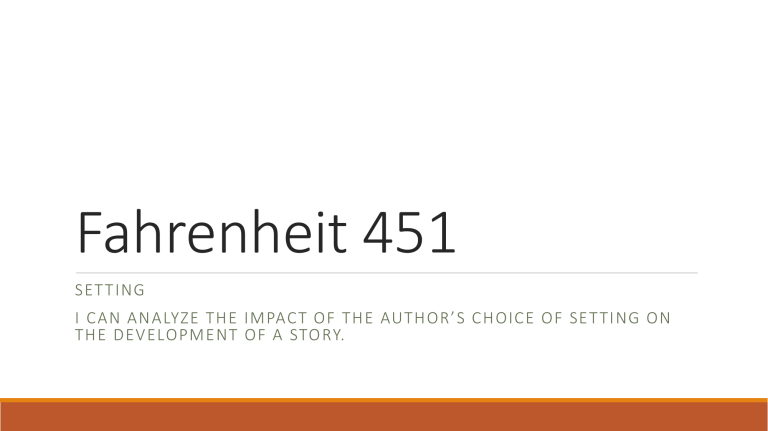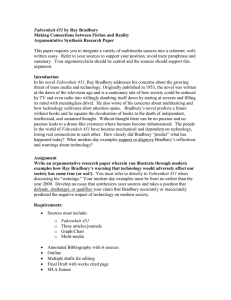File

Fahrenheit 451
SET TING
I CAN ANALYZE THE IMPACT OF THE AUTHOR’S CHOICE OF SET TING ON
THE DEVELOPMENT OF A STORY.
Bell Ringer
• In more than one paragraph, explain what your ideal world would look like.
Setting
In literature, the word ‘setting’ is used to identify and establish the time, place and mood of the events of the story . It basically helps in establishing where and when and under what circumstances the story is taking place.
Setting
Example:
In the first installment of the Harry Potter series, a large part of the book takes place at Harry’s aunt’s and uncle’s place, living in the
“muggle” (non-magical) world with the “muggle” folks, and Harry is unaware of his magical capabilities and blood. This setting establishes the background that Harry has a non-magical childhood with other “muggle” people and has no clue about his special powers or his parents and is raised much like, actually worse than, regular people, till his 11th birthday.
Bradbury’s Setting
• Ray Bradbury, the author of Fahrenheit 451, wrote the novel at a time when the world was threatened by nuclear war.
• World War II ended a few years earlier.
• Many people were questioning the government.
• Fear of Communism was widespread.
• New technologies were emerging, making the world feel smaller.
• Televisions were now common in most households.
Bradbury’s Setting
Ten things Ray Bradbury hates about our society:
• https://www.youtube.com/watch?v=diKXCy10PT0
• Nazi book burnings: https://www.youtube.com/watch?v=s4_j4c7Bop0
Top 10 Notes: Fahrenheit 451
• https://www.youtube.com/watch?v=v5t9WrW_ioU
BACKGROUND RESEARCH
PRESENTATIONS
Brief Synopsis of Fahrenheit 451
• The novel takes place in the 24 th century.
• In this futuristic society, books are considered dangerous and illegal. Citizens are not allowed to own books. When books are found, they are burned, along with the home of the individual who hid them.
• Firefighters no longer put out fires, but rather start them. They are responsible for burning these books.
• Most people are content immersing themselves in technology and meaningless programming.
Dystopia
• Bradbury created a Dystopian society in Fahrenheit 451. A dystopia is characterized as a culture in which:
• There is not equality or fairness.
• People are treated cruelly.
• The government has all power and authority.
• Citizens are controlled through propaganda.
• Citizens are under constant surveillance (or made to feel that way).
• There is a general aura of fear and despair.
• Overall, it’s a corrupt and imperfect society.
Dystopia- Why do you think the dystopian genre is so popular?
Typical Structure of a Dystopian Novel
• A backstory of how this society came to be.
• A hero who believes something is wrong with the society. They might try to make a change, or even escape.
• Generally, the hero meets someone who represents the dystopia.
• The hero then encounters someone who is trying to escape or destroy the dystopia.
• Usually, the story ends unresolved, although the audience still feels a sense of hope and the hero might escape.
Utopia
• Everyone is equal.
• There are no social classes.
• There is usually one group of people that are solely there to ensure the greater good of the society.
• Those that live in a utopia always have hope for the future.
• The “ideal” society.
Mood
In literature, mood is a literary element that evokes certain feelings or vibes in readers through words and descriptions .
Mood
Charles Dickens creates a calm and peaceful mood in his novel “Pickwick Papers”:
“The river, reflecting the clear blue of the sky, glistened and sparkled as it flowed noiselessly on.”
The depiction of idyllic scenery imparts a serene and non-violent mood to the readers
.






